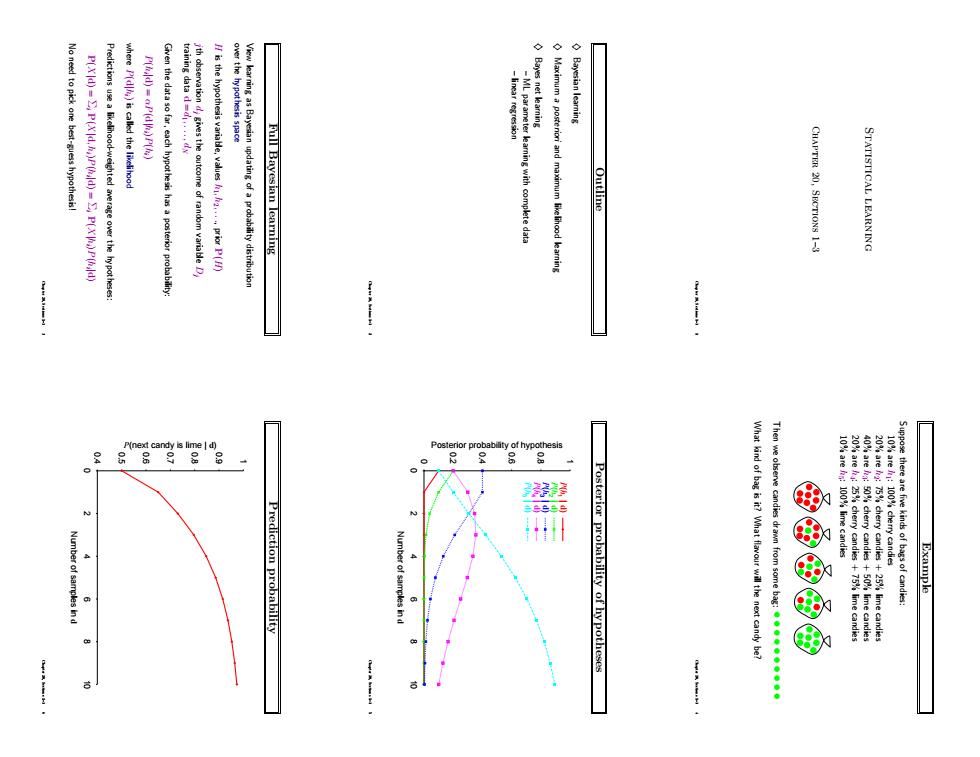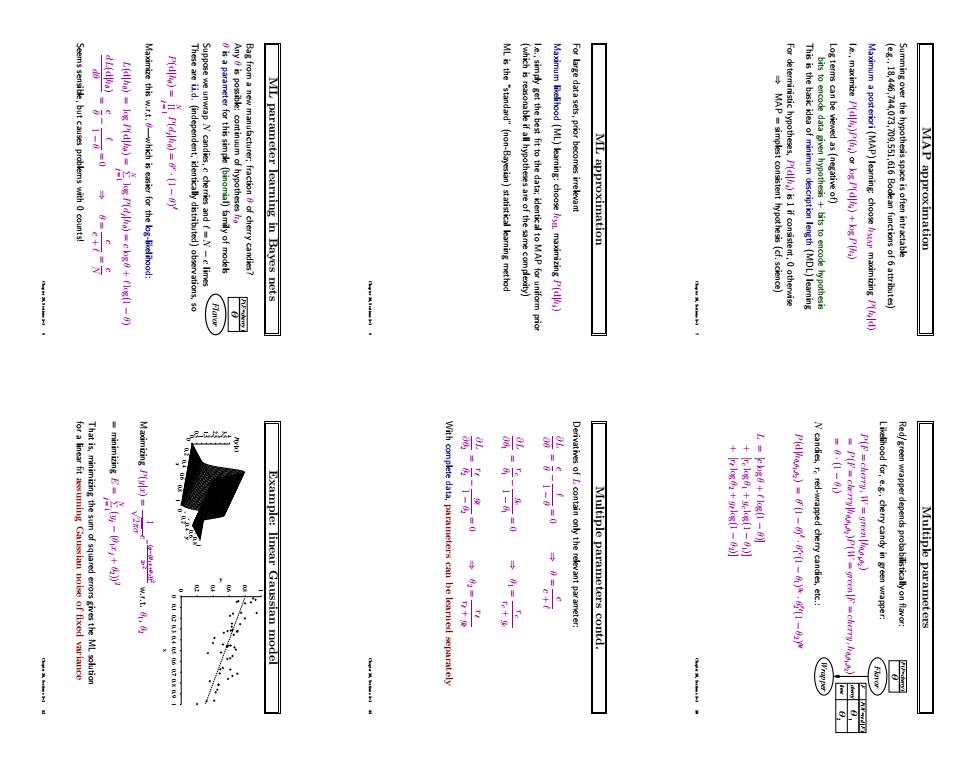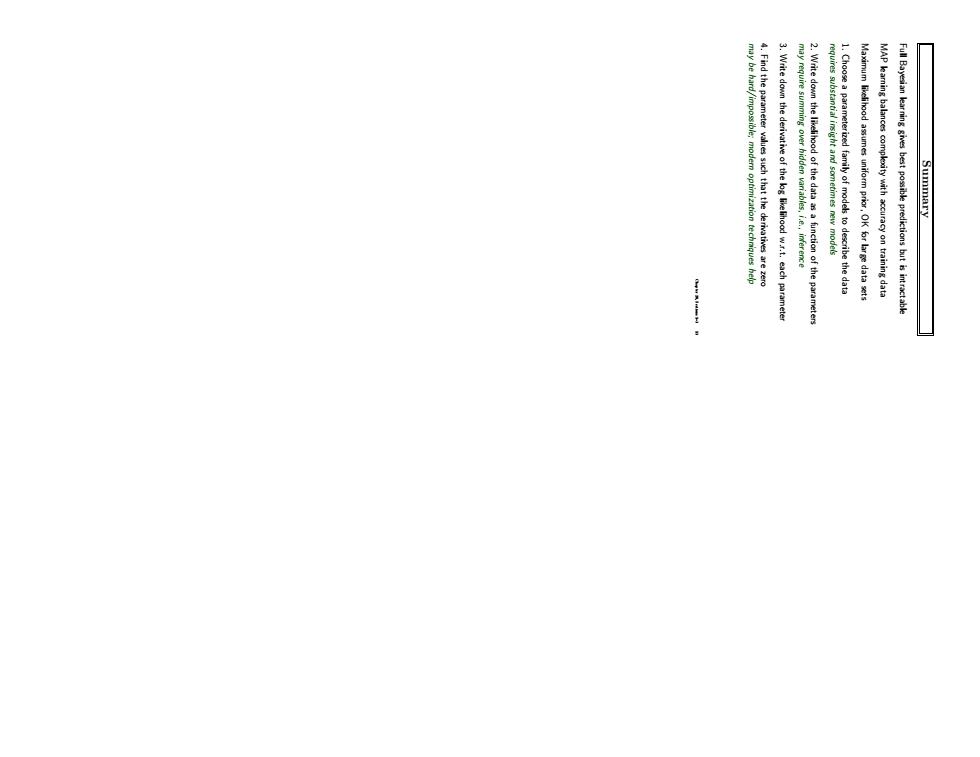
2 P(Xd)=E,P(Xld.P(d)=S,P(XP(d) P(d)is called the likelihe Full Bayesian learning STATISTICAL LEARNIN e observe candies dram from some bag:
Statistical learning Chapter 20, Sections 1–3 Chapter 20, Sections 1–3 1 Outline ♦ Bayesian learning ♦ Maximum a posteriori and maximum likelihood learning ♦ Bayes net learning – ML parameter learning with complete data – linear regression Chapter 20, Sections 1–3 2 Full Bayesian learning View learning as Bayesian updating of a probability distribution over the hypothesis space H is the hypothesis variable, values h1, h2, . . ., prior P(H) jth observation dj gives the outcome of random variable Dj training data d = d1, . . . , dN Given the data so far, each hypothesis has a posterior probability: P(hi |d) = αP(d|hi)P(hi) where P(d|hi) is called the likelihood Predictions use a likelihood-weighted average over the hypotheses: P(X|d) = Σi P(X|d, hi)P(hi |d) = Σi P(X|hi)P(hi |d) No need to pick one best-guess hypothesis! Chapter 20, Sections 1–3 3 Example Suppose there are five kinds of bags of candies: 10% are h1: 100% cherry candies 20% are h2: 75% cherry candies + 25% lime candies 40% are h3: 50% cherry candies + 50% lime candies 20% are h4: 25% cherry candies + 75% lime candies 10% are h5: 100% lime candies Then we observe candies drawn from some bag: What kind of bag is it? What flavour will the next candy be? Chapter 20, Sections 1–3 4 Posterior probability of hypotheses 0 0.2 0.4 0.6 0.8 1 0 2 4 6 8 10 Posterior probability of hypothesis Number of samples in d P(h1 | d) P(h2 | d) P(h3 | d) P(h4 | d) P(h5 | d) Chapter 20, Sections 1–3 5 Prediction probability 0.4 0.5 0.6 0.7 0.8 0.9 1 0 2 4 6 8 10 P(next candy is lime | d) Number of samples in d Chapter 20, Sections 1–3 6

Seems sensible,but causes problems with 0 counts! . Maximize this w.r.t.0-which is easier for the lg-likelihood: These are ii.d.(independent,identically distributed)observations,so Suppose we unwrap N candies,c cherries and (=N-c limes is a parameter for this simple (binomial)family of model Any is possible:continuum of hypotheses Bag from a new manufacturer:fraction 8 of cherry candies? ML parameter learning in Bayes nets ML is the "standard"(non-Bayesian)statistical learning method (which is reasonable if all hypotheses are of the same complecity) le.,simply get the best fit to the data;identical to MAP for uniform prio Maximum likelihaod (ML)learning:choosen maximizing P(d) For large data sets,prior becomes irrelevant ML approximation MAP simplest consistent hypothesis (cf.science) For deterministic hypotheses,P(dis1 if consistent.otherwise This is the basic idea of minimum description length (MDL)learning bits to encode data giwen hypothesis bits to encode hypothesis Log terms can be viewed as (negative of) le.,maximize P(d(ar kg P(d)+kg P() Maximum a posteriori (MAP)learning:choose maimizing P(d) (e.g..18,446,744,073,709,551,616 Bodlean functions of 6 attributes) Summing over the hypothesis space is often intractable MAP approximation for a linear fit assuming Gaussian noise of fixed variance That is,minimizing the sum of squared errors gives the ML solution Derivatives of L contain only the relevant parameter: Multiple parameters contd. +F9+-E) N candies,r red-wrapped cherry candies,etc.: P(F =cherry,W=green llig) Likelihood for,e.g..cherry candy in green wrapper: Red/green wrapper depends probabilisticallyon flavor: w.r.t.8.8 Multiple parameters 1000400070802 Example:linear Gaussian model With complete data,parameters can be learned separately
MAP approximation Summing over the hypothesis space is often intractable (e.g., 18,446,744,073,709,551,616 Boolean functions of 6 attributes) Maximum a posteriori (MAP) learning: choose hMAP maximizing P(hi |d) I.e., maximize P(d|hi)P(hi) or log P(d|hi) + log P(hi) Log terms can be viewed as (negative of) bits to encode data given hypothesis + bits to encode hypothesis This is the basic idea of minimum description length (MDL) learning For deterministic hypotheses, P(d|hi) is 1 if consistent, 0 otherwise ⇒ MAP = simplest consistent hypothesis (cf. science) Chapter 20, Sections 1–3 7 ML approximation For large data sets, prior becomes irrelevant Maximum likelihood (ML) learning: choose hML maximizing P(d|hi) I.e., simply get the best fit to the data; identical to MAP for uniform prior (which is reasonable if all hypotheses are of the same complexity) ML is the “standard” (non-Bayesian) statistical learning method Chapter 20, Sections 1–3 8 ML parameter learning in Bayes nets Bag from a new manufacturer; fraction θ of cherry candies? Flavor P F=cherry ( ) θ Any θ is possible: continuum of hypotheses hθ θ is a parameter for this simple (binomial) family of models Suppose we unwrap N candies, c cherries and ` = N − c limes These are i.i.d. (independent, identically distributed) observations, so P(d|hθ) = YN j = 1 P(dj |hθ) = θ c · (1 − θ) ` Maximize this w.r.t. θ—which is easier for the log-likelihood: L(d|hθ) = log P(d|hθ) = XN j = 1 log P(dj |hθ) = c log θ + ` log(1 − θ) dL(d|hθ) dθ = θ c − ` 1 − θ = 0 ⇒ θ = c c + ` = N c Seems sensible, but causes problems with 0 counts! Chapter 20, Sections 1–3 9 Multiple parameters Red/green wrapper depends probabilistically on flavor: P F=cherry ( ) Wrapper Flavor P( ) W=red | F cherry F 2 lime θ 1 θ θ Likelihood for, e.g., cherry candy in green wrapper: P(F = cherry, W = green|hθ,θ1,θ2 ) = P(F = cherry|hθ,θ1,θ2 )P(W = green|F = cherry, hθ,θ1,θ2 ) = θ · (1 − θ1) N candies, rc red-wrapped cherry candies, etc.: P(d|hθ,θ1,θ2 ) = θ c (1 − θ) ` · θ rc 1 (1 − θ1) gc · θ r` 2 (1 − θ2) g` L = [c log θ + ` log(1 − θ)] + [rc log θ1 + gc log(1 − θ1)] + [r` log θ2 + g` log(1 − θ2)] Chapter 20, Sections 1–3 10 Multiple parameters contd. Derivatives of L contain only the relevant parameter: ∂L ∂θ = θ c − ` 1 − θ = 0 ⇒ θ = c c + ` ∂L ∂θ1 = rc θ1 − gc 1 − θ1 = 0 ⇒ θ1 = rc rc + gc ∂L ∂θ2 = r` θ2 − g` 1 − θ2 = 0 ⇒ θ2 = r` r` + g` With complete data, parameters can be learned separately Chapter 20, Sections 1–3 11 Example: linear Gaussian model 0 0.2 0.4 0.6 0.8 1 x 0 0.2 0.4 0.6 0.8 1 y 0 0.5 1 1.5 2 2.5 3 3.5 4 P(y |x) 0 0.2 0.4 0.6 0.8 1 0 0.1 0.2 0.3 0.4 0.5 0.6 0.7 0.8 0.9 1 y x Maximizing P(y|x) = 1 √ 2πσ e − (y−(θ1 x+θ2 )) 2 2σ 2 w.r.t. θ1, θ2 = minimizing E = XN j = 1 (yj − (θ1xj + θ2)) 2 That is, minimizing the sum of squared errors gives the ML solution for a linear fit assuming Gaussian noise of fixed variance Chapter 20, Sections 1–3 12

may be hard/impossible:modern optimization techriques help 4.Find the parameter values such that the derivatives are zero 3.Write down the derivative of the g likelihood w..t.each parameter may require summing over hidden variables,i.e..inference 2.Write down the likelihood of the data as a function of the parameters requires substantial insight and sometimes new models 1.Choose a parameterized family of modes to describe the data Maximum likelihood assumes uniform prior,OKor large data sets MAP kearning balances complxity with accuracy on training data Full Bayesian learning gives best possible predictions but is intractable
Summary Full Bayesian learning gives best possible predictions but is intractable MAP learning balances complexity with accuracy on training data Maximum likelihood assumes uniform prior, OK for large data sets 1. Choose a parameterized family of models to describe the data requires substantial insight and sometimes new models 2. Write down the likelihood of the data as a function of the parameters may require summing over hidden variables, i.e., inference 3. Write down the derivative of the log likelihood w.r.t. each parameter 4. Find the parameter values such that the derivatives are zero may be hard/impossible; modern optimization techniques help Chapter 20, Sections 1–3 13